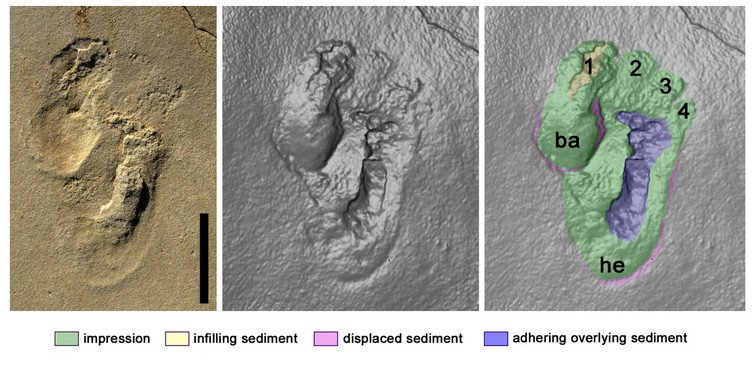Advanced Non-Human Civilizations Could Have Lived On Earth Millions Of Years Ago – Scientists Say
Ellen Lloyd – MessageToEagle.com – If there was a highly advanced ancient civilization present on Earth long before the appearance of modern humans would even know it?
We tend to assume Homo sapiens is the only species ever to have developed advanced technology, but scientists say it is possible very sophisticated, non-human civilizations may have existed on our planet millions of years ago!
The problem is to find traces of these unknown beings. While this may not be possible, or extremely difficult, we cannot dismiss the possibility our planet was inhabited long before Homo sapiens emerged.

Credit: sdecoret – Adobe Stock
The intriguing “Silurian Hypothesis”, developed in 2018 by Gavin Schmidt, a climate modeler at NASA’s Goddard Institute, is a thought experiment that assesses modern science’s ability to detect evidence of a prior advanced civilization, perhaps several million years ago.
We know that modern humans have been present for approximately 200,000 years, but life has existed on this planet for 3.5 billion years.
Current science offers evidence the first known single-celled organisms appeared on Earth about 3.5 billion years ago, roughly a billion years after Earth formed.
Eventually, after a long while, more complex life started to evolve, but it was first about 600 million years ago that the first multicellular animals appeared.
Is this all there is to this evolution story of our planet, or are we missing some important historical events that have never been documented due to lack of evidence?
According to Adam Frank, a professor of physics and astronomy at Rochester and a co-author of the paper “The Silurian Hypothesis: Would it be possible to detect an industrial civilization in the geological record?”, we should be careful assuming our modern civilization is the most advanced one that has ever set foot on this planet.
“Do we really know we were the first technological species on Earth? We’ve had an industrial society for only about 300 years, but there’s been complex life on land for nearly 400 million years,” Professor Frank explained.
Professor Frank points our attention to the fact that traces of previous sophisticated civilizations may be difficult to find. He argues that if our modern civilization went extinct, any civilization that might arise on Earth millions of years in the future may not even recognize our existence.
In the same way, we look for traces of earlier civilization that existed on Earth millions of years ago, but we cannot find any convincing evidence.
Naturally, the best way to prove the existence of past sophisticated civilizations would be if we could discover some physical artifacts, but Professor Frank is doubtful this will ever occur.
“Our cities cover less than one percent of the surface,” he says. Any comparable cities from an earlier civilization would be easy for modern-day paleontologists to miss. And no one should count on finding a Jurassic iPhone; it wouldn’t last millions of years, Gorilla Glass or no.”
“The fraction of life that gets fossilized is always extremely small and varies widely as a function of time, habitat, and degree of soft tissue versus hard shells or bones.
Fossilization rates are very low in tropical, forested environments, but are higher in arid environments and fluvial systems. As an example, for all the dinosaurs that ever lived, there are only a few thousand near-complete specimens, or equivalently only a handful of individual animals across thousands of taxa per 100,000 years. Given the rate of new discovery of taxa of this age, it is clear that species as short-lived as Homo Sapiens (so far) might not be represented in the existing fossil record at all.
The likelihood of objects surviving and being discovered is similarly unlikely,” the researchers explain.
If we cannot locate physical artifacts, we may be lucky and find some fossilized bones that could offer evidence another advanced species walked the Earth millions of years ago. Discoveries of this kind have been made but they have always been met with skepticism because the evidence speaks against the accepted evolution theory.
As an example, we can mention, a set of controversial, human-like footprints that have put the theory of human evolution to the test.
The footprints are about 5.7 million years old from Trachilos in western Crete, have an unmistakably human-like form. Could they offer evidence someone walked the Earth millions of years ago, and these beings were not humans?

Controversial Discovery Of 5,7-Million-Year-Old Footprints On Crete Could Re-Write History Of Human Evolution – Read more
There are also other controversial fossil discoveries in the same region, including the iconic 3.7-million-year-old Laetoli footprints from Tanzania which show human-like feet and upright locomotion,
Professor Frank and Gavin Schmidt understand the difficulties the Silurian Hypothesis is facing and propose we should use human technology to search for chemical relics of an ancient terrestrial civilization.
Basically, this means we can utilize current technology to study industrial chemicals persisting in ocean sediments. Then, we can see if we can find traces of similar chemicals in the geologic record.
We can “address the likely geologic consequences of human industrial civilization and then compare that fingerprint to potentially similar events in the geologic record,” researchers write in their paper.

We have come along way, but maybe “someone” was much more advanced long before we appeared on this planet? Credit: Public Domain
Another way to explore this theory further is searching for life in the Universe, and scientists suggest we should search for artifacts not just on the lunar surface, but also on asteroids or buried on Mars. There are several places in space where such objects could theoretically survive for hundreds of millions or even billions of years.
MessageToEagle.com reported earlier, “Dr. Abraham “Avi” Loeb, a Professor of astronomy at Harvard thinks we should focus more on space archaeology that is a fascinating but neglected science field. By mapping sites from space, we can expect to find the unexpected. There are ancient ruins and artifacts scattered all across our own planet. Could such ancient sites not be present on alien worlds? Could not extraterrestrial have built monuments and left behind evidence of their existence?
Many scientists are convinced this could be the correct approach. Not only would we learn about the existence of long-gone, unknown civilizations that once lived on our planet, but we could also finally find convincing proof of highly advanced extraterrestrial life.
Maybe once in the very distant past, there was a very sophisticated civilization that lived on the Moon, Mars, and planet Earth before being wiped out by some unknown powerful cosmic forces?
Dr. John Brandenburg, who has a Ph.D. in Theoretical Plasma Physics from the University of California at Davis has previously suggested an ancient Martian civilization was destroyed by a nuclear attack from another extraterrestrial race.
It may sound like sci-fi but anything is possible, and by being open-minded and curious, we can learn more about us and our place in the Universe.
The beauty of real and honest science is to explore all possibilities while searching for the truth. We may come across unorthodox answers that shatter our deepest beliefs, but that’s the price we must be prepared to fay for gaining knowledge.
Written by – Ellen Lloyd – MessageToEagle.com
Copyright © MessageToEagle.com All rights reserved. This material may not be published, broadcast, rewritten or redistributed in whole or part without the express written permission of MessageToEagle.com
Related Posts
-
 Zombie Stars – Unusual Space Objects That Refuse To Die Despite Multiple Powerful Explosions
No Comments | Dec 16, 2017
Zombie Stars – Unusual Space Objects That Refuse To Die Despite Multiple Powerful Explosions
No Comments | Dec 16, 2017 -
 Francesco Lentini: The Three-Legged Wonder Man With Four Feet And 16 Toes Who Became A Celebrity
No Comments | Feb 24, 2017
Francesco Lentini: The Three-Legged Wonder Man With Four Feet And 16 Toes Who Became A Celebrity
No Comments | Feb 24, 2017 -
 Vishaps – Flying Serpents And Dragon-Like Beings – Ancient Flying Machines Of Armenia?
No Comments | Sep 7, 2015
Vishaps – Flying Serpents And Dragon-Like Beings – Ancient Flying Machines Of Armenia?
No Comments | Sep 7, 2015 -
 Seismic Echoes Reveal A Mysterious ‘Donut’ Inside Earth’s Core
No Comments | Sep 3, 2024
Seismic Echoes Reveal A Mysterious ‘Donut’ Inside Earth’s Core
No Comments | Sep 3, 2024 -
 Funny People Have Higher IQ – Science Reveals
No Comments | Jun 24, 2017
Funny People Have Higher IQ – Science Reveals
No Comments | Jun 24, 2017 -
 Mysteries Of The Yellow Emperor – The ‘Son Of Heaven’ From Regulus
No Comments | May 10, 2014
Mysteries Of The Yellow Emperor – The ‘Son Of Heaven’ From Regulus
No Comments | May 10, 2014 -
 Cosmic Mystery – What Huge Object Caused The Hole In One Of Saturn’s Rings?
No Comments | Jun 22, 2017
Cosmic Mystery – What Huge Object Caused The Hole In One Of Saturn’s Rings?
No Comments | Jun 22, 2017 -
 Door To Hell In Turkmenistan: Giant Darvaza Crater Has Been On Fire For Years
No Comments | May 21, 2016
Door To Hell In Turkmenistan: Giant Darvaza Crater Has Been On Fire For Years
No Comments | May 21, 2016 -
 10 Great Ancient Life Lessons From Buddha How To Change Your Life Rapidly
No Comments | Jul 16, 2015
10 Great Ancient Life Lessons From Buddha How To Change Your Life Rapidly
No Comments | Jul 16, 2015 -
 Mystery Of The Seven Sages In Ancient Myths And Legends
No Comments | Feb 20, 2016
Mystery Of The Seven Sages In Ancient Myths And Legends
No Comments | Feb 20, 2016
